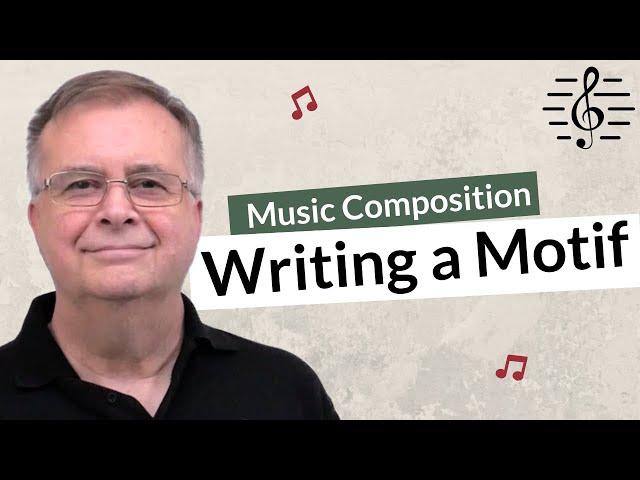
How to Come Up With a Motif - Music Composition
Комментарии:

The way I write music is to improvise and noodle around until I find a motif that I like and I develop it using call and response and develop a complex structure across different starting notes, modes, and modulations until it creates a whole story with counterpoint and longer phrases. This sound is more pleasing with all the different permutations interacting than how most people seem to use their knowledge of theory in a more scientific abd logical way. I can really improvise a whole piano sonata doing this with no mistakes.
Ответить
what do you mean by using it upside down?
Ответить
what about if your motif doesn't end on a harmony note, but a passing note
Ответить
I'm not a composer. I don't even consider myself a musician, I dabble occasionally but I can't even read sheet music, I just click the boxes in the midi sequencer. I also didn't sleep at all last night so my brain is running on half power. Yet, the way you explained it, I understood almost all of it. The only thing I'll have to look up is which chords contain which notes as I do not know it by heart. That is how good of a teacher you are, thank you so, so much!
Ответить
Music theory at it's best and application. Thanks 73
Ответить
This was very helpful! Thank you
Ответить
Fabulous! Thank you Gareth.
Ответить
Yet another excellent video
Ответить
that motif almost made the T-Rex break out of their fences
Ответить
Could you show us how to compose a song ? 😀
Ответить
Thank you so much really from the bottom of my heart. With every video of yours that i watch you answer questions that have been holding me back in music production for years. I couldnt have made it without you!
Ответить
Thanks
Ответить
Great lesson thank you
What is the biggest difference between motif and subphrases and fragments??

Thank you kindly.
May the Lord bless you in Jesus name.

Few disadvantages. These motifs are filled up with interval of second, which is dissonant, and then we meet abrupt solution in larger interval at the end. It's not smooth. Also, here melody is written around the chord and it's chord that supposed to be written around melody. And harmony notes got it's quality, so better to play it at order of prime, fifth, third and back to fifth. Doesn't sound good played at random.
My best receipt for motif, is to play intervals sorted by tension (fifth, quarter, thirds, seconds), linked with passing notes. Can be played back and forth. Sixth and minor seventh can be used with thirds, as the tension is the same. It draws nice shape of mountains on a score sheet.
Or other receipt is to play intervals by short passages of the same interval, sorted in groups by it's tension. So first I play second using few seconds, then in next group thirds, sixths and minor sevenths, using thirds, sixths and minor seventh, and so on by quarters to the fifth. As a variation it can be fifth played by seconds, fourth played by thirds and sixth played by fourths.
Groups not necessarily has to be sorted in order after each other. They can wave: 3rds, 4ths, 2nds, 5ths.
But it is not classical. This is rather modern, spectral development. Mr. Jarre used to play like this in 80's and 90's (have been studying his themes for 30 years).
Cheers!

All your videos are addictive.. one doesn’t want to miss anything.. Very relevant and enjoyable !!
Ответить
thank you! great lessons and teaching style!
Ответить
Thanks for this lesson. I'm enjoy learning.
Ответить
Tnk u master
Ответить
Nice teaching sir
Thanks....

Great video! What about musical cryptograms?
Ответить
Your the best thanks you!!
Ответить
Sir excellent presentation. I want to learn writing for strings section techniques . Please guide me. If u have full course please let me know
Ответить
Thank you - this was helpful!
Ответить
thanks for your's amazing teaching
:i have a question
can i write unaccented after accented passing note like
:
harmony _unaccented _accented_harmony
or just
harmony_accented_unaccented_harmony
?
! thank you very much

Wow, when you played the f major motive you made up, I immediately heard how the melody continues. It's amazing, thank you!
Ответить
You are a most wonderful music teacher! Thank you so much for everything you do!
Ответить
I thought you were going to play the Bach’s fugue in c minor in the first example and when you played A natural my ears cringed so hard😂😂
Ответить
Nothing wrong with bugle calls.
Ответить
Thanks!
Ответить
I really enjoyed this video. I really like that I can now use this to analyze some pieces better and understand what is happening in the melody!
Ответить
Great lesson! Thank you very much!
Ответить
thanks
Ответить
Thank you so much for these videos. I've watched countless videos trying to explain melody and motif composition from music producers and it never made any sense. You explain everything perfectly and intricately and it has been so helpful. Really appreciate your work!
Ответить
Good solid teaching!
Ответить
Can an auxillary note also be a passing note? Isn’t the 8th note in the second measure also a passing note?
Ответить
Thanks for this. It has actually given me an idea
Ответить
Hi, this is useful. I am actually writing a musical at present.
Ответить
Thanks!
Ответить
This is so useful thank you!
Ответить
Thank you for your wonderful
clear explanations.

Your teaching is very good presented and easily to understand. Thank you!
Ответить
Amazing video sir. Thank you.
Ответить
Thank you for the lesson!
Ответить
Great lesson! Easy to understand and very informative!
Ответить
I'm at the moment trying to write more counter punctuel in a String quartet I'm writing.
Maybe It would be an Idea for you to teach how to Counter point in ensembles.
Good Video, helped a lot as always! ☺


![[FREE] Lil Durk Type Beat 2024 - "REALITY" / Lil Durk Type Beat [FREE] Lil Durk Type Beat 2024 - "REALITY" / Lil Durk Type Beat](https://ruvideo.cc/img/upload/UWZwODFMTmljQ20.jpg)























